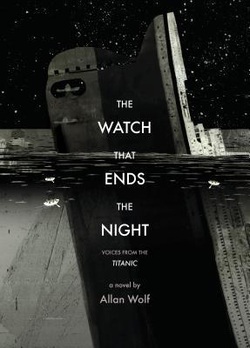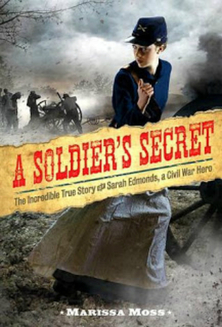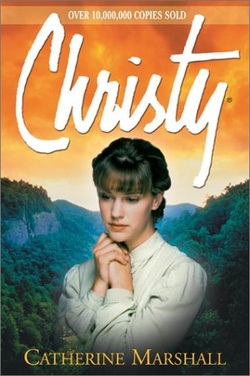 The Watch That Ends the Night: Voices from the Titanic by Allan Wolf
ISBN: 978-0-7636-3703-3
Wolf, A. (2011). The watch that ends the night: Voices from the titanic. Somerville, MA: Candlewick Press.
Plot Summary
Told in verse, the lives of 24 passengers onboard the Titanic and the iceberg they hit, are traced during the week they were traveling on “The Greatest Ship Ever Built.” Passengers include some of the famous and infamous. Margaret Brown, later to be known as “The Unsinkable Molly Brown,” John Jacob Astor, and Thomas Andrews are among the famous, while Bruce Ismay is an infamous. Then there are the children, Lolo and Frankie Goldsmith, who form a kind of club on the ship. The rat scurries along, concerned only with finding food and avoiding capture. The iceberg is the most ominous, as it beckons the ship every closer. Love stories blossom between Jamila and another passenger. The background stories of passengers and why they are on the fated ocean liner are mentioned, as the characters themselves speak about their experiences. Interspersed between the days leading up to the disaster are newspaper reports and the undertaker’s notes. There are few surprises as to what happens at the end, some die and some are saved.
Critical Evaluation
Written in a free-verse narrative structure, The Watch That Ends the Night provides a lyrical note to the Titanic tragedy, but is no less dramatic or tragic. Through the poetry, one senses a sort of romantic feel to the characters, their lives, and reasons for traveling, which makes it all the more difficult to know some will die by the end of the book. It is a novel, but Wolf uses real people who sailed on the Titanic, some famous, others forgotten by time, but all were affected by the sinking. The voice of the rat can be irritating at times “food/food/scurry/scurry,” but his single-mindedness realizes the will of living beings to survive. The most ominous of the characters is undoubtedly the iceberg, as it waits for a ship to cross its path. In the end, it is reduced to nothing as it melts, much like the lives lost over 100 years ago. The sheer number of characters makes remembering who is who a bit difficult in the beginning. A list of characters helps with the confusion, and their unique voices eventually lead to remembering individual storylines. The inclusion of summary biographies, references, and factual material in the appendices will leave readers both satisfied and questioning. Satisfied that there is an ending to the story, and questioning how the disaster could have been prevented.
Reader’s Annotation
The story of the Titanic told by 24 different characters in verse. Who lives and who dies?
About the Author
Allan Wolf was born in 1963 in Storrs, Connecticut. His family moved to Virginia, and he attended all his education, from elementary to graduate school in Blacksburg, Virginia. Wolf attended Virginia Tech University and earned a bachelors and Master’s in English. Although a poet at a young age, Wolf holds his life as a writer began when he was twelve, and started writing on his bedroom walls as a sort of diary. After earning his Master’s, he taught college composition at his alma mater, but left to join Poetry Alive!, a traveling poet troupe. His experiences with Poetry Alive! and schools led Wolf to begin writing books for children. He usually writes longhand, and quickly and inaccurately types it later.
Wolf has written seven books, fiction and non-fiction, for adults and children. He has earned several honors including a School Library Journal Best Book and ALA Best Books for Young Adults. His interest to poetry is not solely in writing; Wolf has memorized hundreds of poems. Wolf is married, has three children, and lives in Asheville, North Carolina.
Genre
Historical Fiction/Action & Adventure
Curriculum Ties
Titanic
Booktalking
In the point of view of one of the characters, pretend it is 50 years after the sinking, and what your life is like now.
Reading Level/Interest Level
RL: 5th grade
IL: 9th grade and up
Challenge Issues
Possible challenge issues may include the point of view of the rat and iceberg.
In my defense file, I would include the following:
1) Library Mission Statement
2) Library Selection Policy approved by any or all of the following individuals—principal, school board, district librarian OR library manager, city council, mayor.
3) Library Bill of Rights adapted from CSLA Bill of Rights, AASL Bill of Rights and/or ALA Bill of Rights
4) Reviews, both positive and critical, from respected sources such as School Library Journal, VOYA, Booklist
5) Rationale for book inclusion for titles anticipated to be controversial, frequently challenged, or created when a book is challenged including: summary, audience, purpose, controversial issues and how they are handled
6) How the book fits within Common Core Standards or State Standards
7) Reconsideration form for challenger to complete—include a section asking which part was of particular concern, if the entire book was read, and what other similar titles are suggested instead
8) Student reviews from those who have read the book and either enjoyed or disliked the book and why.
Why Included
The 100th anniversary of the Titanic was last year, and there is still immense interest in the disaster.
Others in the Series
N/A
References
Wolf, A. (n.d.). Biography. Retrieved from http://allanwolf.com/bio.htm
 A Soldier’s Secret: The Incredible True Story of Sarah Edmonds, Civil War Hero by Marissa Moss
ISBN: 978-1-41970-4277
Moss, M. (2012). A soldier’s secret: The incredible true story of sarah edmonds, civil war hero. New York: Amulet Books.
Plot Summary
Sarah Emma Edmonds was born in Canada to a farmer and his wife. She had a sickly brother who was unable to work in the fields, so Sarah took over the responsibility of working with her father. Mr. Edmonds was abusive to his wife and son, but never mistreated his daughter. When Sarah was fourteen, her father sold her favorite horse to a neighboring farmer. Sarah was devastated and slept in the barn. Two years later Sarah’s father told her he had arranged a marriage between Sarah and the man who purchased her horse, an old man. This strengthened Sarah’s resolve and she ran away, disguising herself as a boy and named herself Frank Thompson. Sarah’s travels took her to the United States where she convinced a storekeeper to hire her as a travelling salesman. She was happy with this job until the Civil War began and Sarah knew she had to join the Union cause. Much of the continuing novel is about Sarah’s time in the army. While a soldier, she served as a battlefield nurse, regular soldier, mail carrier, personal secretary, and spy. Sarah was captured by the Confederates, and had a few close calls about her gender, but always managed to keep her secret. As Frank, she made close friends for the first time in her life, and found it increasingly difficult to keep Sarah to herself. As the war drags on, and she falls in love with a fellow soldier, will Sarah make it to the end and see the Union victory?
Critical Evaluation
A moving novel based on the real-life experiences of Sarah Emma Edmonds. Moss used Edmonds’ autobiography and other first-person documents to create a convincing first-person narrative of a woman living as a man and fighting in the Civil War. The first-person point-of-view serves to make Edmonds a relatable individual despite her living over 150 years ago. Her daily worries of being discovered as a woman and her friendships with fellow soldiers are all the more meaningful in first-person. As Edmonds learns about war, friendships, and enemies, the reader is right beside her. Realistic in the portrayal of wartime atrocities, Moss never goes so far as to be gratuitous. Amputations, illness, pain, and death were a daily experience of Civil War soldiers, and are presented as realities in a way appropriate for a young adult novel. Appendices include letters, timelines, and photographs to illustrate the historical nature of the novel. Readers will also appreciate character biographies that explain who the real person was, and what really happened to them after the war. Some battle descriptions were a bit long, but in a novel about war, were a necessary aspect. A woman born before her time, Edmonds was a brave and loyal individual, dedicated to her adoptive country and people.
Reader’s Annotation
Sarah Emma Edmonds decides to dress as a man, call herself Frank Thompson, and join the Union Army during the Civil War. Acting as a soldier, nurse, mail carrier, and spy will she be able to keep her secret?
About the Author
Marissa Moss sent her first book to publishers when she was nine, but it was rejected. She tried again as an adult and had to wait five years before one of her stories was accepted. Moss has now written over 40 books, and continues to writes. She is most well known for her Amelia’s Notebook series in which a grade school student chronicles her life in black-and-white composition notebooks. Amelia was not planned as a series, but it was so popular Moss decided to write more. Moss typically writes for elementary-aged students, and A Soldier’s Secret is her first novel for young adults.
Marissa Moss has loved writing and drawing since she was a young child. She was born in Pennsylvania, but moved to southern California when she was two. Moss attended San Jose State University and studied art, but disagreed with the teachers and their philosophies. She transferred to the University of California, Berkeley and changed her major to history. She credits these classes as teaching her how to research, very helpful for her historical books. After graduating, Moss took classes at the California College of Arts and Crafts, but it was too expensive and time-consuming to complete another degree. Moss waited tables for a while until her first book was accepted, and considers herself fortunate to have made a career out of writing.
Genre
Historical Fiction
Curriculum Ties
Civil War/Women’s History
Booktalking
Frank Thompson has a secret, a big one. He is a soldier, mail carrier, and spy for the Union Army. Frank Thompson is also female.
Reading Level/Interest Level
RL: 6th grade
IL: 8th grade and up
Challenge Issues
Possible challenge issues include a female disguising herself as a man.
In my defense file, I would include the following:
1) Library Mission Statement
2) Library Selection Policy approved by any or all of the following individuals—principal, school board, district librarian OR library manager, city council, mayor.
3) Library Bill of Rights adapted from CSLA Bill of Rights, AASL Bill of Rights and/or ALA Bill of Rights
4) Reviews, both positive and critical, from respected sources such as School Library Journal, VOYA, Booklist
5) Rationale for book inclusion for titles anticipated to be controversial, frequently challenged, or created when a book is challenged including: summary, audience, purpose, controversial issues and how they are handled
6) How the book fits within Common Core Standards or State Standards
7) Reconsideration form for challenger to complete—include a section asking which part was of particular concern, if the entire book was read, and what other similar titles are suggested instead
8) Student reviews from those who have read the book and either enjoyed or disliked the book and why.
Why Included
I felt I needed more historical fiction books, and I enjoyed Marissa Moss’ Amelia series when I was younger.
Others in the Series
N/A
References
Moss, M. (n.d.). Marissa moss: Author-illustrator. Retrieved from http://www.marissamoss.com/abouttheauthor.php
 Rachel’s Secret by Shelly SandersISBN: 978-1-926920-37-5Sanders, S. (2012). Rachel’s secret. Toronto, ON: Second Story Press. Plot Summary Rachael is Jewish and Mikhail is Christian, but that has not stopped their friendship. They both enjoy skating on the frozen pond during winter and talking with their friends. On the same evening Mikhail kisses Rachel, he is murdered. The only witness is Rachel, who had forgotten her scarf and returned to collect it. She sees the murder, and hears Mikhail call them Uncle and Cousin. Too afraid to tell anyone, Rachel races home and mourns in private. When word of the murder gets out, the Christian community is outraged, and turns against the Jews. They claim Mikhail was murdered because the Jews need blood to make their unleavened bread, a blood murder. Local newspapers fuel the hatred, and propaganda is everywhere. Even the police are blaming the Jews despite there being no evidence against them. Rachel and Sergei, Mikhail’s friend, meet in secret and Rachel finally admits she saw Mikhail’s uncle and cousin. Sergei tells his police chief father, but he doesn’t care. Tensions escalate until riots break out, and many others are murdered. Rachel knows the information she carries can stop the riots, but if no one will listen to her, the knowledge is useless. Critical Evaluation Based on true events of Christian and Jewish riots and pogroms in early 20th century Russia, Rachel’s Secret explores the reasons behind one such event. While a compelling narrative, Rachel and Sergei’s relationship seems quickly forced to suit the purposes of the novel. Mere acquaintances one day and serious confidants just weeks later is not realistic. Additionally, Sergei has been raised in a deeply anti-Semitic household and is rather daring to defy his father and upbringing. Students unfamiliar with the threads of anti-Semitism throughout the centuries will find themselves confused with the level of violence and hatred perpetrated against a group of people. Even those knowledgeable about the events still find unanswered questions about why the Jewish people were so reviled. The violence of the pogroms will startle some readers especially because they were unprovoked. Murder takes place where children can witness and hear. The decimation afterwards is truly heartbreaking, and the lives of so many have been damaged forever. Characters with hopes and dreams in the first chapter are now desolate and broken, their dreams banished forever. Rachel and her family will be safe in the United States, but what about all those who must stay behind? Only family will remember the lives that have been taken. The lives that have been ruined have no other recourse but to stay where they are, or move to another area and hope anti-Semitism is not as rampant. Reader’s Annotation After witnessing the murder of her Christian friend Mikhail, Rachel sees her town crumble under anti-Jewish propaganda. About the Author Rachel’s Secret is Shelly Sander’s first book and is currently in its third printing. Sanders’s novel has been recognized by the Sydney Taylor Book Awards and the Association of Jewish Libraries. She has completed a second novel and is waiting to hear from her publisher, and is writing her third. Before turning to novel writing, Sanders was a freelance writer for fourteen years for the Toronto Star, Reader’s Digest, Maclean’s, and Canadian Living. Rachel’s Secret is inspired partly by her grandmother’s experiences as a Russian Jew who escaped to Shangahi. Shelly Sanders was born in Toronto, Ontario, but moved to Illinois when she was eight. Her family moved frequently, never staying more than two years. As an adult Sanders returned to Canada and attended the University of Waterloo earning an Honours Degree in English. She continued to Ryerson University with a degree in Journalism. For the next few years, Sanders worked in public relations until the birth of her first child. Sanders has been married for over twenty years, has three children, and four pets. Genre Historical Fiction Curriculum Ties Jewish history Women in Russia Booktalking Consequences of keeping secrets. Reading Level/Interest Level RL: 5th grade IL: 8th grade and up Challenge Issues Though historical fiction, the themes presented including anti-Semitism and ethnic riots may be possible challenge issues. In my defense file, I would include the following: 1) Library Mission Statement 2) Library Selection Policy approved by any or all of the following individuals—principal, school board, district librarian OR library manager, city council, mayor. 3) Library Bill of Rights adapted from CSLA Bill of Rights, AASL Bill of Rights and/or ALA Bill of Rights 4) Reviews, both positive and critical, from respected sources such as School Library Journal, VOYA, Booklist 5) Rationale for book inclusion for titles anticipated to be controversial, frequently challenged, or created when a book is challenged including: summary, audience, purpose, controversial issues and how they are handled 6) How the book fits within Common Core Standards or State Standards 7) Reconsideration form for challenger to complete—include a section asking which part was of particular concern, if the entire book was read, and what other similar titles are suggested instead 8) Student reviews from those who have read the book and either enjoyed or disliked the book and why. Why Included I needed more historical fiction novels and also felt this was an important historical time period. Others in the Series Rachel's Promise (Book #2 Released Fall 2013) Rachel Book #3 (Released 2014) References Sanders, S. (2013). About shelly sanders. Retrieved from http://www.shellysanders.com/about-shelly-sanders
 Christy by Catherine Marshall ISBN: 0-310-24163-4 Marshall, C., (1967). Christy. New York: McGraw Hill Plot Summary Christy, a 19-year-old from a well-to-do family hears a Christian revival minister speak about his missionary work in Appalachia. Christy is drawn to his message and decides to volunteer her time and become a schoolteacher in Cutter Gap. When she arrives, Christy is overwhelmed by the poverty and ignorance of the people she meets. The locals are suspicious and unwelcoming to outsiders, and are reluctant to ask for her help. Alice, a Quaker woman, helps Christy see the goodness in the people and acceptance of their ways. There is also a young minister David Grantland, another outsider, and Dr. Neill MacNeill, an agnostic who has lived in the mountains. She learns about the people’s customs and way of life, and learns to appreciate them all. As time passes, Christy and the people form relationships, and she begins teaching the children, and some of the adults. Christy also grows closer to the young pastor and doctor. Critical Evaluation A heart-warming story. God and Christian themes are a tenet throughout, but are not the main focus. Rather, the actions and attitudes of many characters are guided by their faith, but are not managed or controlled. Superstitious individuals also prevent this from becoming a overly moralizing Christian novel. The atheist doctor is also not reviled, but treated with respect and understanding. His reasons for his lack of faith are convincing, and while not agree with, are accepted. If the religious tones are too much, glancing over them is sufficient and will not ruin or lessen the story. Alice’s Quaker ways are calming, and even non-Christian readers will find themselves supporting her quiet and peaceful views. The characters are what make Christy a memorable novel. Their plights, concerns, and successes are celebrated by the other townspeople and readers alike, as it is easy to become invested. The simple, daily lives of the Appalachian people were mundane to those living them, but are written with a sincere interest that turns them into interesting accounts of very different lives. There is moonshining, feuding, and killing, but also hard workers, loving families, and lasting friendships. In the end, what you believe in is not as important as how you live your life. Reader’s Annotation Christy, a young woman from an educated family goes to the very poor Appalachian Mountains to be a teacher. Her relationships with the locals, including the pastor and doctor, change all their lives. About the Author Catherine Marshall’s first book, Mr Jones, Meet the Master came about after her husband’s death when she needed to support her small family. Due to its success, Marshall decided to write A Man Called Peter, her husband’s biography. It remained on the New York Times bestseller list for fifty weeks. She then turned to novel writing and wrote Christy. The novel is partly based on her mother’s experiences teaching in Appalachia before her marriage. Her books have been translated into thirty-five languages and sold over eighteen million copies. Catherine Marshall was born in Tennessee to a reverend and his wife. She graduated from Agnes Scott College and married a minster named Peter Marshall at twenty-two. Marshall wanted to be a writer, but devoted the next years to being a wife and mother. She contracted tuberculosis and was confined for over two years while she recovered. Just twelve years after they were married, Peter Marshall died of a heart attack. Left a poor widow, Catherine Marshall decided to compile and edit her husband’s sermons into a book. It was a success and she continued to write. Ten years after her husband’s death, Marshall remarried. Her second husband was Leonard LeSourd, editor of Guideposts. Marshall died in 1983 at 68. Genre Christian/Historical Fiction Curriculum Ties Appalachian History Booktalking Imagine a young woman leaving all that is familiar, and going to Appalachia. A beautiful place, but one with poverty and little knowledge of modern ways. Reading Level/Interest Level RL: 8th grade IL: 9th grade and up Challenge Issues I do not foresee any challenges. But if there were I would have my Defense File ready. In my defense file, I would include the following: 1) Library Mission Statement 2) Library Selection Policy approved by any or all of the following individuals—principal, school board, district librarian OR library manager, city council, mayor. 3) Library Bill of Rights adapted from CSLA Bill of Rights, AASL Bill of Rights and/or ALA Bill of Rights 4) Reviews, both positive and critical, from respected sources such as School Library Journal, VOYA, Booklist 5) Rationale for book inclusion for titles anticipated to be controversial, frequently challenged, or created when a book is challenged including: summary, audience, purpose, controversial issues and how they are handled 6) How the book fits within Common Core Standards or State Standards 7) Reconsideration form for challenger to complete—include a section asking which part was of particular concern, if the entire book was read, and what other similar titles are suggested instead 8) Student reviews from those who have read the book and either enjoyed or disliked the book and why. Why Included I read Christy for the first time several years ago and it stayed with me. It is a lovely book and one I reread. Others in the Series N/A References Peter Marshall Ministries. (2013). Legacy. Retrieved from http://www.catherinemarshallministries.com/legacy/catherine-marshall/
|




 RSS Feed
RSS Feed